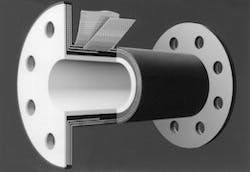Elastomer Valves Provide Solutions
Red Valve Company and Tideflex Technologies
undefinedThe most critical parts of any valve are its engineering and construction. Elastomer valves are built to specifically provide low maintenance and long life spans in the toughest applications. The design of an elastomer valve provides trouble-free wear resistance that outperforms and outlasts many other valve styles.
Elastomer valves are ply-reinforced, much like automotive tires. Special plies of nylon, polyester and Kevlar fabrics provide the structural support within an elastomer valve and form the pressure-containing vessel. The wear surface of an elastomer pinch valve is vulcanized to the ply and is chosen on the basis of compatibility with the process fluid. Elastomer valves can be built to suit almost any process condition. Large-diameter and high-pressure designs are available, as are variations in elastomer thickness for severe conditions.
Keeping backflow in check
Year after year, millions of dollars are spent in the United States after combined sewer overflow (CSO) systems allow receiving waters to enter into sewage treatment plants and collection systems. The unique characteristics of elastomer valves make them ideal for backflow prevention in these applications.
Developed specifically for CSO and diversion chamber applications, elastomer valves such as the Tideflex check valve and the Tideflex CheckMate inline check valve can eliminate costly backflow from oceans, rivers and interceptors. Elastomer check valves can be installed in the upstream or downstream end of a diversion chamber or pipeline. Simply insert the valve inside or onto any size pipe and clamp it into position; no modification to the pipe or structure is required. This inherent design makes elastomer check valves extremely user-friendly and virtually maintenance-free.
The all-rubber construction of elastomer check valves provides trouble-free service because there are no mechanical parts to fail or corrode. Their unique design allows for near-100% flow and a tight seal to eliminate backflow completely. These valves even seal on entrapped solids. Their elastomer construction also gives them extremely low head loss. Elastomer check valves completely drain the pipeline and are sensitive enough to open with as little as 1 in. of water.
In a pinch
Pinch valves also use engineered elastomer technology. At the heart of every pinch valve is an elastomer sleeve that can manage the toughest flow applications in sludge—specifically, return and waste activated sludge, grit and lime slurry. The sleeve provides excellent corrosion resistance, abrasion resistance and pressure containment. Pinch valves are ideal for both isolation and flow control applications, and they can be customized with optional “cone sleeve” trim.
When abrasive particles strike the hard surfaces of traditional metal valves, the energy of impact is completely absorbed by the metal surface, prematurely wearing seats, weirs, rotating discs, plugs and balls. Additionally, these abrasive particles pack behind the ball and plug, scoring the sealing surface and creating leaks.
When abrasive particles strike the elastomer surface of a pinch valve, the impact is absorbed and deflected back into the process. Extremely resistant elastomers wear at a far slower rate than ceramics or metal alloy valve trims. Pinch valves are full-ported with no crevices or seats that can foul valve operation.
Another major benefit of pinch valves is that they include no packing to maintain. Pinch valves provide double containment without the need for packing. Therefore, they are often installed in buried service applications and if fugitive emissions are a concern.
Accurate, repeatable linear flow control and drop-tight, bi-directional shutoff make elastomer valves such as Red Valve Company’s pinch valves ideal for influent flow control and during pretreatment as wastewater is passed through a screen to remove grit. Debris such as stones, gravel and metal particles are extremely abrasive and will wear metal-seated valves quickly. The elastomer sleeve within a pinch valve absorbs the impacts of these particles and, therefore, will last even longer than expensive metal alloys. The elastomer sleeve is also easy and inexpensive to replace.
Caustic and chemical solutions, such as lime, are used to neutralize the pH of wastewater. These materials present problems for metal valves, but the elastomer sleeve within a pinch valve resists abrasion and corrosion. The flexing action of an elastomer sleeve breaks dewatered solids apart each time the valve is actuated—even after long periods of inactivity. In sludge, waste-activated and return-activated applications in which the percent solids is greatest, pinch valves outperform all other valves.
Into the future
Over the past 30 years, the process of wastewater treatment has seen dramatic change as the world population increases and concern over the environment grows. Ever more stringent regulations for wastewater quality have met with high-tech engineering to create elastomer valves that provide innovative solutions for the most difficult challenges faced by a wastewater treatment plant.
